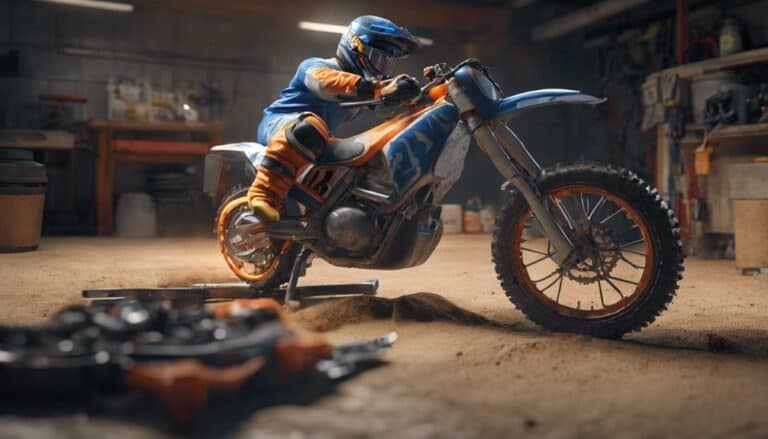Inspect the brake fluid level and color, ensuring it's clear and at the recommended amount. Check the front master cylinder matches bike specs and test brake light function. Examine brake line routing, noting if properly placed. Assess braided quality and potential pinching risks. Maintain cleanliness of calipers for excellent performance, watching for even brake pad wear. Confirm rotor quality and avoid damaged ones. Verify fluid level in the rear reservoir and foot pedal play. Look for bluing on rotors as a sign of overheating. Ensuring every component is in excellent shape keeps you safe while riding.
Key Takeaways
- Check brake fluid levels and color for clarity and proper amount.
- Inspect brake lines for braided quality and correct routing.
- Maintain cleanliness of calipers, check pad wear and piston condition.
- Examine rotors for even wear, opt for high-quality replacements.
- Verify rear brake fluid, pedal action, caliper condition, and rotor heat indicators.
Front Master Cylinder Inspection
When examining the front master cylinder on your dirt bike, begin by checking the brake fluid level and color to ensure proper maintenance. Sufficient brake fluid is essential for top-notch braking performance. Make sure the fluid is at the recommended level and appears clear, not murky or discolored, indicating potential contamination. Maintaining the correct master cylinder on your bike is necessary to ensure the system functions as designed. Verify that the front master cylinder matches the specifications for your dirt bike model to uphold safety standards.
Inspect the functionality of the brake light connected to the front master cylinder. A working brake light is crucial for signaling your stops to other riders or vehicles for safety on the trails. Additionally, examining the brake lines attached to the front master cylinder is important. Confirm that the brake lines are correctly routed to prevent any pinching or kinks that could compromise braking efficiency. Proper routing of brake lines ensures consistent brake performance when riding.
Examination of Brake Lines
Inspect the brake lines on your dirt bike for braided quality and proper routing to maintain peak performance and durability. Braided brake lines offer superior longevity and resistance to wear compared to rubber lines.
Confirm the brake lines are correctly routed to prevent pinching or kinks that could impede brake fluid flow. Check that the brake lines aren't trapped or rubbing against the chassis during operation, as this can lead to essential wear and potential damage.
If you notice any signs of wear or damage on the brake lines, it's vital to replace them promptly to uphold best braking efficiency. Regularly inspecting and maintaining your brake lines will contribute to the overall safety and reliability of your dirt bike's braking system.
Assessment of Calipers
To properly evaluate the calipers on your dirt bike's brake system, begin by maintaining cleanliness for best brake performance. Dirty calipers can hinder brake performance, so cleaning them is essential.
When examining calipers, check the brake pads for even wear, as this indicates proper caliper functionality. Additionally, inspect the remaining thickness of the brake pads to evaluate their lifespan accurately.
It's vital to examine the condition of the pistons within the calipers to ensure they're functioning correctly, as this directly impacts brake operation. Detailed cleaning procedures for calipers can be found in instructional videos for a thorough maintenance routine.
Inspection of Rotors
During your inspection of the rotors on your dirt bike's brake system, focus on identifying any scoring or damage present on the rotor surfaces. Here are some key points to keep in mind:
- Look for even wear and tear across the entire surface of the rotors to guarantee consistent braking performance.
- Opt for OEM or high-quality rotors to ensure better braking efficiency and longevity.
- Avoid using rotors with visible cracks, deep grooves, or signs of excessive wear as they can compromise braking effectiveness.
- Verify mileage claims by evaluating the condition of the rotors; this inspection can help in determining the lifespan of the braking components.
Rear Brake System Check
Inspect the rear brake reservoir on your dirt bike to make sure the fluid level is appropriate and check for any signs of contamination in the color. Additionally, verify the proper foot pedal action and play to guarantee effective engagement of the rear brakes. Confirm the correct routing of braided lines to prevent kinks or obstructions that could hinder the rear brake system's performance. Examine the rear brake caliper for its condition and cleanliness, as any issues here can impact braking performance. Keep an eye out for bluing on the rotors, as it indicates excessive heat and potential problems with the rear brake system.
| Rear Brake System Check | |
|---|---|
| Fluid Level | Verify adequate amount and quality |
| Foot Pedal Action | Ensure proper play and engagement |
| Braided Lines Routing | Check for kinks or blockages |
| Rear Brake Caliper | Inspect for cleanliness and condition |
| Bluing on Rotors | Look for signs of excessive heat |
Conclusion
Now that you have completed the brake system check on your dirt bike, you can rest assured knowing that your brakes are in excellent condition.
Just like a well-oiled machine, your bike's braking system is vital for safe and efficient riding.
By following these guidelines regularly, you can guarantee that your brakes continue to perform at their best and keep you in control on the trails.

